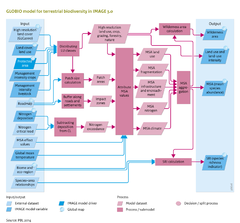Terrestrial biodiversity/Description: Difference between revisions
Jump to navigation
Jump to search
No edit summary |
Oostenrijr (talk | contribs) No edit summary |
||
| Line 1: | Line 1: | ||
{{ComponentDescriptionTemplate | {{ComponentDescriptionTemplate | ||
|Reference=Bartholome et al., 2004; UNEP-WCMC, 2005; Dixon et al., 2001; Visconti et al., 2011; Alkemade et al., 2012; Alkemade et al., 2011a; Bouwman et al., 2002b; Bobbink et al., 2010; DMA, 1992; Meijer and Klein Goldewijk, 2009; Benitez-Lopez et al., 2010; UNEP, 2001; Verboom et al., submitted; Faith et al., 2008; Musters et al., submitted; | |Reference=Bartholome et al., 2004; UNEP-WCMC, 2005; Dixon et al., 2001; Visconti et al., 2011; Alkemade et al., 2012; Alkemade et al., 2011a; Bouwman et al., 2002b; Bobbink et al., 2010; DMA, 1992; Meijer and Klein Goldewijk, 2009; Benitez-Lopez et al., 2010; UNEP, 2001; Verboom et al., submitted; Faith et al., 2008; Musters et al., submitted; | ||
|Description=The GLOBIO model calculates changes in biodiversity in terrestrial ecosystems, based on seven drivers of biodiversity change: land-use change, land-use intensity, climate change, atmospheric nitrogen deposition, infrastructural development, encroachment and fragmentation. | |Description=The GLOBIO model calculates changes in biodiversity in terrestrial ecosystems, based on seven drivers of biodiversity change: land-use change, land-use intensity, climate change, atmospheric nitrogen deposition, infrastructural development, encroachment and fragmentation. | ||
Four steps in the model are distinguished: | Four steps in the model are distinguished: | ||
Revision as of 14:34, 1 July 2014
Parts of Terrestrial biodiversity/Description
| Component is implemented in: |
|
| Projects/Applications |
| Key publications |
| References |
|
